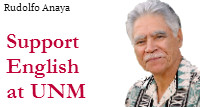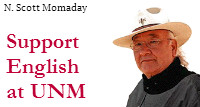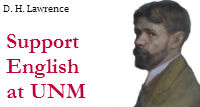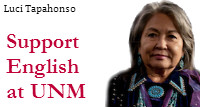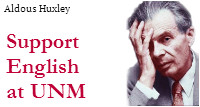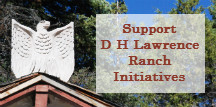Fall 2015 Course Descriptions
500.001: Introduction to the Professional Study of English
TR 1230-1345
Scarlett Higgins, shiggins@unm.edu
This course will prepare students for graduate study in English. The semester will be divided up into three parts. First, we will read about and discuss the history of English as a field of study and as a university department, as well as some contemporary debates about the "crisis" in the humanities, the English job market, and the changing nature of the English Department in the 21st century. Second, we will read about and discuss some classic and current texts in literary theory, ranging from classic readings in the New Criticism and semiotics to recent works in the environmental humanities and the digital humanities. Third, we will discuss how to be successful as a graduate student at UNM, as well as how to do practical things like familiarize yourself with scholarship in your field of interest, present your work at conferences, and submit your work for publication. Course assignments will include a bibliographic exercise, a review of an academic journal, and a 10-page essay that will be presented as a conference paper at the end of the semester.
511.001: Psychoanalytic Theory
TR 1100-1215
Scarlett Higgins, shiggins@unm.edu
This course will serve as an intensive, graduate-level introduction to psychoanalytic theory as it is practiced in literary and cultural studies. After covering the definitional texts from Sigmund Freud, and their equally significant revisitations by Jacques Lacan, the remainder of the course will emphasize feminist revisions to psychoanalytic theory. Primarily, we will examine the works of Julia Kristeva, of the so-called "French Feminists," and the recent work of practicing psychoanalyst and visual artist Bracha Ettinger. No previous experience with psychoanalytic theory is necessary to take this course, though serious dedication to learning the language of the discourse will be necessary. As such, I have added to our list of required texts The Language of Psycho-Analysis. This is an indispensible reference guide to what may otherwise seem the baffling field of terminology used by psychoanalytic theorists. Learning Outcomes: At the conclusion of this course, students will be able to: -- recognize and deploy correctly a wide variety of psychoanalytic terminology. -- compare and assess several of the most significant trends in psychoanalytic discourses. -- plan and compose a research-based essay (or other comparable project) in which the above discourses are used as a part of literary or cultural analysis.
513.001: Science, Medical, and Environmental Writing
TR 0930-1045
Natasha Jones, nnjones@unm.edu
This course will examine scientific, medical, and environmental writing through a n umber of theoretical lens. Using theories and frameworks from the fields of technical communication, human-computer interaction (HCI), user-centered design (UCD), rhetorical studies, and rhetoric of science, we will analyze and deconstruct how scientific, medical, and environmental texts are value-laden and have the potential to empower, as well as marginalize and disenfranchise. The semester will conclude with students producing and presenting analytical seminar papers on a topic of their own choosing.
519.001: Visual Rhetoric
TR 1530-1645
Stephen Benz, sbenz@unm.edu
Visual Rhetoric is defined as the art of using images and other visual elements to inform or persuade. A course in visual rhetoric, therefore, purposes to introduce students to the working vocabulary of this rhetoric, as well as the fundamentals of theory and practice associated with document design. In ENGL 419, we will study the basic principles of graphic design and explore some theoretical approaches that can help us analyze examples of visual rhetoric. We will study how visual elements contribute to and affect the meaning of documents. From a practical standpoint, we will consider how various aspects of document design (including layout, use of headings, typography, photos, illustrations, charts, tables, and graphs) help documents achieve (or fail to achieve) their rhe torical purpose. The assignments in the course will focus on both theory and practice. Some assignments will involve the analysis of visual rhetoric in a variety of documents. Other assignments will involve creating documents that employ some of the principles we study.
520.001: Writing with Tropes
TR 0800-0915
Jerome Shea, jshea@unm.edu
This course focuses on rhetorical tropes and schemes, on recognizing them and using them in our writing. You will develop a store of useful tropes to amaze your friends and confound your enemies. Not only will we write, but we will analyze other writings, learning to spot the coy apophasis, the elusive hypophora, the whimsical hyperbaton, the flashy chiasmus, the modest brevitas, the pulsing polysyndeton, and many more. No exams, just writing: five or six short papers.
520.004: Blue Mesa Review
W 1400-1550; F 1500-1700
Emily Rapp, erapp@unm.edu
521.002: Creative Writing Workshop Fiction
M 1600-1830
Julie Shigekuni, jshig@unm.edu
522.003: Creative Writing Workshop Poetry
R 1600-1830
Diane Thiel, dthiel@unm.edu
This graduate course will have an emphasis on generating new poems and revising poems in progress. Because students arrive in a graduate workshop with a variety of backgrounds, styles, and interests in poetry, we will also engage in ongoing discussions about lineage and the different schools of thought in poetry. The course will include some exploration of writing which crosses genres, such as the verse novel. The course will also involve some focus on the theory and practice of translating poetry and on prose written about the art. Students will write one critical essay or review and give a brief presentation. The essay might respond to selected poems/poets in a reflective way (as writers engaged in the art). As students write and collect their poem s together for the course portfolio, they will be thinking about connective themes, etc. in the development of a future body of work (working toward a book, or the creative dissertation). Workshops, as well as individual and class assignments, will sometimes focus on this future goal as well. Portfolios of 20-30 pages, including about 8-10 significantly revised pieces, will be due near the end of the semester.
537.001: Teaching Composition
MTWRF 0900-1300 08/04/14-0815/14
Cristyn Elder, celder@unm.edu
This rigorous course is designed for new teachers in UNM's Core Writing Program. You will learn and apply current theory and pedagogy in Composition Studies and Rhetorical Genre Studies to guide you as a teacher of diverse student writers. In addition to selected readings on the teaching and research of composition, this course offers hands-on mentoring through classroom observation and feedback on the development of classroom materials that you can use during your first semester as a teacher in our program.
537.002: Teaching Composition
MTWRF 0900-1300 Aug 4 - Aug 15; 1 hr/wk Aug 18- Dec 13
Bethany Davila, bdavila@unm.edu
This course is designed for new teachers in UNM's Core Writing Program. You will learn and apply current theory and pedagogy in Composition Studies and Rhetorical Genre Studies to guide you as a teacher of diverse student writers. Our focus will be on helping students gain skills, strategies, and know-how that will transfer to other college courses across the disciplines and to students' personal and professional environments. We aim to help students develop the capacities that will allow them to negotiate these new contexts and write successfully in them. This class will provide many opportunities to reflect on your current and possibly future career as a composition instructor through reading, research, class discussion, conferencing, and course projects. This is a three-credit graduate course.
540.001: Multimodal and Online Pedagogies
T 1600 -1830
Tiffany Bourelle, tbourell@unm.edu
In this class, students will learn the theory behind online teaching and multimodal composition. Beth Hewett and Christa Ehmann (2004) indicate that teachers are often concerned about teaching online for the first time; however, they suggest that this worry is caused by a lack of proper training. This course will provide such training, helping graduate students understand the best practices of designing an online course, facilitating course discussions, holding online conferences, and providing feedback. In addition, the class will also be practical, as students will develop their own course shells to teach in subsequent semesters. The online classes will be part of our online program, eComp, which is based on a multimodal pedagogy, where students are asked to choose their medium in response to the needs of their audience and the purpose of the document. As such, this seminar will teach graduate students the theory and pratice of multimodal composition, helping them create materials such as assignments and multimodal instructional tools that mimic the texts first-year students develop.
540.002: Pedagogy Teaching Adult ESL Studies
W 1900-2130
Bee Chamcharatsri, bee@unm.edu
542.001: Major Texts in Rhetoric
W 1600-1830
Andrew Bourelle, abourelle@unm.edu
When ancient Roman statesman Cicero was assassinated during the turmoil in the wake of Julius Caesar's death, it was reported that the rhetorician's head and hands, which had spoken and written such powerful rhetoric, were severed and nailed on display in Rome. The gruesome act demonstrates how powerful Cicero's words had been, but it also serves to illustrate the power of rhetoric in Roman society. Moreover, with the benefit of 2,000 years of hindsight, we can now see that Cicero's rhetoric, as well as the importance of rhetoric throughout antiquity, has continued to influence education and communication in the Western world. Modern society has changed significantly since the ancient Greek and Roman world; the emphasis on orality as the primary means of communication has long since been abandoned in favor of writing and, more recently, multimedia communication. However, many of the concepts established during antiquity remain important today. Students in English 542 will explore the history and theory of rhetoric, focusing on the foundations of rhetoric developed by the ancient Greeks and Romans. Students will read primary texts by rhetoricians from ancient Greece and Rome (Plato, Aristotle, Cicero, Quintilian, and others), as well as contemporary scholarship about their influence on modern rhetorical theories. While the course will provide a historical survey of major texts, the curriculum will focus on the applicability of classical rhetoric to students' modern scholarship and pedagogy. Students will consider not only what the classical rhetoricians had to say, but also how what they said can be used in their own teaching and learning.
548.001: Advanced Old English
TR 1100-1215
Jonathan Davis-Secord, jwds@unm.edu
In this class, we will return to the earliest recorded form of English and read some of the oldest literature ever written in the language. We will read accounts of the founding of England and later Viking invasions, the lives of holy men, and the reworking of the book of Exodus into an epic poem. All readings will be done in the original Old English. Prerequisite: knowledge of Old English.
551.001: Viking Women
MW 1730-1845
Helen Damico, hdamico@unm.edu
The theme of the course will be women's defiance"of authority, of the patriarchal system, of nature and the elements, of hung er and disease. The society captures the time of settlement of Iceland, Greenland, and Vinland, and the stories exemplify the rugged life in the wilderness. The women are "defiant" of their men, traditional notions of femininity and love, and seize the right to individual action and avenge personal outrage. The course will be loosely organized in the following segments: Concubines and Matriarchs; Eroticism and Commerce; Explorers and Warriors. The historical period covered will be that of the settlement from the ninth-century through early the early eleventh-century. The sagas themselves were written in largely in the thirteenth and early fourteenth centuries. Why should there be this disparity of time between the events and their codification? Class readings of primary materials: Egil's Saga, Eyrbyggja Saga, Laxdaela Saga, Njal's Saga, The Vinland Sagas (Graenlendinga Saga and Eirik's Saga), The Saga of the Volsungs. Reading of Secondary Sources will be found on E-Reserves. Although the sagas will be read in translation, students who have taken one semester of the language course in Old Norse are welcome; special projects will be designed for them. Requirements: Quizzes, midterm, final, and paper. This course applies toward credit both for the minor in Medieval Studies and the requirements for the graduate programs in Medieval Studies.
555.001: The "Living Muses of Great Britain": Women Writers, 1725-1817
MW 1600-1715
Carolyn Woodward, woodward@unm.edu
In the eighteenth and early nineteenth centuries, the novels of British and Irish women writers were best-sellers. Their fiction was passionate, angry, and romantic, and their experiments with form ranged from the epistolary to the dialogue-rich "realist." In this course for graduate students only, we will study the work of the most influential female writers of the Georgian and Regency periods, and the culture in which their work emerged. We will ask not only how women wrote but how they "were written"--what possibilities existed or could be imagined for women as individuals, as members of families, as citizens, and as authors. We will study a small number of authors in depth: Eliza Haywood, Charlott E. Lennox, Jane Collier, Sarah Fielding, Frances Burney, Maria Edgeworth, and Jane Austen. Of these writers, we will ask: what forms of social authority were available to women? what kinds of worlds were created or denied as particular notions of gendered identity and authority were represented in fiction? Writing requirements: several brief essays, one term paper. If requested, I'll be happy to send a list of texts via email.
562.001: American Realism & Naturalism
TR 1400-1515
Kathryn Wichelns, wichelns@unm.edu
As literary movements, American realism and naturalism simultaneously respond to and articulate the crises of the post-Civil War period. The era is marked by a series of profound cultural shocks: demographic changes, as non-Protestant and non-white immigration to the U.S. increases; unprecedented economic inequality, urbanization and overcrowding; federal withdrawal from the South and the rise of Jim Crow; continued Westward expansionism; the 1898 Spanish-American War, and the shift towards an imperialist foreign policy that it in part represents; the emerging visibility of working women; and scientific discourses arising in the wake of Darwin. These authors reject literary romanticism and promote a descriptive encounter with real life. At the same time, this notion of the "real" reflects period-specific ideologies of race, gender, work, class, nation, region, the public sphere, private life, and the act of writing itself. We will focus primarily on short fiction, nonfiction prose, poetry, and novels by writers including Charles W. Chesnutt, Rebecca Harding Davis, Theodore Dreiser, W.E.B. DuBois, Paul Laurence Dunbar, Sui Sin Far, Charlotte Perkins Gilman, Henry James, Sarah Orne Jewett, Jacob Riis, Upton Sinclair, Mark Twain, Ida B. Wells, and Zitkala-Ša. Students will be evaluated based on an in-class presentation and one article-length argumentative research paper.
565.001: Chicano/a Literature
MW 1230-1345
Melina Vizcaino-Aleman, mviz@unm.edu
Chicano/a literature became a recognized field in the aftermath of the Civil Rights era, and the post-Civil Rights period saw the recovery of many early twentieth-century texts. This course begins with the recovered novel, George Washington Gómez, written by Américo Paredes in the 1930s but first published by the Recovery Project in 1990. We will explore the criticism and debate about Paredes' work to understand better the field of Chicano/a literature, its canon, and its debates. Other readings include folktales, short fiction, poetry, autobiography, and essays by writers such as Jovita González, Fray Angélico Chávez, and Fabiola Cabeza de Baca from the early twentieth century, and Tomás Rivera, Cherrie Moraga, Lorna Dee Cervantes, Jimmy Santiago Baca, and Richard Rodriguez from later in the century. We will also read a range of criticism to explore the themes of region, race, and gender in the selected works, and we will consider written texts alongside of oral and visual texts that elucidate and inform Chicano/a literature. Students come away with a better understanding of the aesthetics, the culture, and the historical longevity of Chicano/a literature.
579.001: Mediterranean Cosmocivics
W 1600-1830
Raji Vallury, rvallury@unm.edu
Mediterranean Cosmo-Civics maps a postcolonial cartography of cities in authors who come from Italy, India, Lebanon, Pakistan, Tunisia, and Turkey, and whose imaginations traverse, occupy, and reconfigure the Mediterranean in fractally manifold ways. Through the fractious spatiotemporal junctions of three continents, the course traces the literary mappings of cities as cosmo-political spaces: as communities of fate conjoined by forces of capital and empire that are global in scope and expansionist in reach, but also as republics, nations, and worlds; as sites of inscription of a democratic civility, defined as a universally shared capacity for participation in a life of the common good. The study of the historical, geographic, and metaphoric crossings between th e Mediterranean and the Indian Ocean will allow us to inflect the notion of cosmopolitanism--today understood as an epiphenomenon of multiple cultural affiliations, nomadic rootlessness, and hybrid subjectivities - towards the concept of a cosmo-civics: the secular and tolerant practice of political debate, dialogue, and argument. Along our journey, we will consider contemporary theoretical reflections on terms such as world systems theory, world literature, and a global civil sphere in order to understand how literary engagement with a history of confluent encounters may reorient a practice of civility and toleration. Novels include: Italo Calvino, Invisible Cities; Abdelwahab Meddeb,Talismano; Amin Maalouf, Leo Africanus; Orhan Pamuk, My Name is Red; Amitav Ghosh, In an Antique Land; Tariq Ali, A Sultan in Palermo; and Salman Rushdie, The Enchantress of Florence.
579.001: Representations of Africa
TR 1400-1515
Walter Putnam, zarafanm@gmail.com
"Ex Africa semper aliquid novi" (Pliny) Africa is hot! Beginning with Antiquity, Pliny recognized that something new always comes out of Africa. One can hardly open the newspaper, turn on the radio or television, or walk down the street without hearing something about Africa. This course offers an exploration of the myriad discourses that have created Africa from a European perspective: historical, anthropological, literary, medical, scientific, and visual. This fascination with the fabled continent has a long genealogy extending back to Antiquity and continuing right up to contemporary Euro-American culture. Africa was not so dark until the Europeans arrived and constructed a mythical land that suited their supremacist and expansionist purposes. The representation of Africa by non-Africans raises thorny problems of racial politics, cultural practices, and the global circulation of images that attest to the European fascination and repulsion for all things African. We will read Conrad's Heart of Darkness and Chinua Achebe's famous "An Image of Africa: Racism in Conrad's Heart of Darkness." We will examine the fabrication, collection, and dissemination of representations that contributed to what Michel Leiris termed a "phantom Africa." This course is cross-listed in Comparative Literature and Africana Studies. It is more appropriate for graduate students but advanced, motivated undergraduates are welcome to attend. Please contact me for further information.
587.001: Genre Studies: Image in Narrative
T 1730-2000
Daniel Mueller, dmueller@unm.edu
Fiction is typically regarded as a dramatic art form, sharing with plays and films the capacity to engage an audience's imagination through action that seems, when successful, urgent, immediate, necessary, real. When, as writers, we portray movement and render external conflict in scene such that our readers infer the internal conflicts and motivations of our characters, we are operating at our most dramatic and, at these moments, have the most in common with playwrights and screenwriters. But most fiction isn't written entirely in the 3rd person objective voice, and unless we're Hemingway writing "Hills Like White Elephants" or Carver writing "Fat," we can limit ourselves unnecessarily. In this course, we will examine the intersection of narration and lyricism in the interest of better understanding how fiction may be served by image.
587.002: Genre Studies: The Native American Oral Tradition
W 1600-1830
N. Scott Momaday, nmomaday@unm.edu
650.001: Seminar: Literature, Nature, Practice
T 1600-1930
Gary Harrison, garyh@unm.edu
Drawing upon a variety of works from the eighteenth and early nineteenth centuries, we will situate romantic-era writing at the intersection where socio-political reform and revolution, aesthetics, and natural history converge in generative and influential ways for literary and cultural production, as well as for ecological thought. We will emphasize in particular the way literary approaches to the natural world may recalibrate our orientation toward nature and the environment, as well as shape or incent structures of feeling that predis pose us to act in certain ways within our environment. Readings will include poetry by James Thomson, Thomas Gray, Charlotte Smith, William Wordsworth, Samuel Taylor Coleridge, Henry Kirke White, John Clare, Walt Whitman, and Emily Dickinson; fiction by Jane Austen and Emily Bronté; non-fiction prose by Gilbert White, Thomas Robert Malthus, Dorothy Wordsworth, William Cobbet; and philosophical, historical, and critical essays by Jean Jacques Rousseau, Immanuel Kant, Friedrich Schiller, Martin Heidegger, among others. A major, thoroughly researched and critically informed article-length paper will be required; as well as collaborative presentations focusing primarily upon the theoretical and critical material.
660.001: Modernism and the American West
R 1600-1930
Daniel Worden, dworden@unm.edu
Modernism is typically associated with urban centers like New York and Paris. Contrary to this canonized version of modernism, this course will explore how modernism also emerged out of and represented the American West. We will begin with a discussion of the “New Modernist Studies” that have broadened what we talk about when we talk about modernism and the renewed interest in “regional modernism” that has brought new focus to the American West’s role in modernist aesthetics. We will then move on to read and discuss a variety of modernist texts, ranging from dime novels and comic strips to poems and novels.
This course will make extensive use of materials housed in the Center for Southwest Research, including the Center’s substantial collections of dime novels, modernist periodicals, and rare books. We will also read widely from work on U.S. imperialism, modernist aesthetics, and periodical studies.
Primary readings will include prose and/or poetry by Mary Austin, Mariano Azuela, Willa Cather, Ed Dorn, Ralph Ellison, Edna Ferber, F. Scott Fitzgerald, Zane Grey, Dashiell Hammett, Ernest Hemingway, D.H. Lawrence, Nat Love, Mabel Dodge Luhan, D’Arcy McNickle, Américo Paredes, Ishmael Reed, Lynn Riggs, Frank Waters, and Nathanael West, as well as dime novel Westerns, Hergé’s Tintin in America, and selections from George Herriman’s Krazy Kat comic strip.
